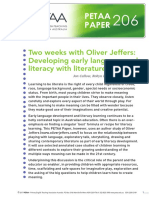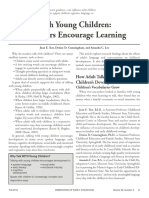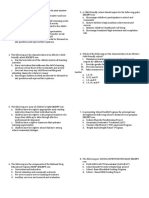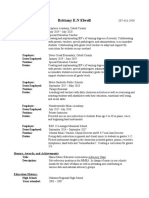Getting It Right From The Start
Uploaded by
DÉBORA DRUMGetting It Right From The Start
Uploaded by
DÉBORA DRUMGetting It Right from the Start
The Case for Early Parenthood Education
By Thomas G. Sticht at home. Schools can and should do their part to close this gap,
but parents, by reading to their children and interacting with
O
ne hundred fifty-three thousand words per week. That’s them in positive and encouraging ways, need to do their part,
the difference between the 215,000 words per week too.
that the average child in a privileged home hears and The idea that families need to provide enriching educational
the 62,000 words per week that the average child in a activities is not new. In 1908, Edmund Burke Huey, regarded as
family on welfare hears. I’ll explain the research behind these “one of the foremost leaders” in educating children with learning
numbers later; for now, just consider how staggering the differ- disabilities,1 wrote, “The school of the future will have as one of its
ence is. And consider the implications. Hearing language is the important duties the instruction of parents in the means of assist-
first step in learning to read and write and make sense of the ing the child’s natural learning in the home.”2 This insight was just
world. one of many in his classic work The Psychology and Pedagogy of
The language gap that results in the achievement gap begins Reading, a 500-page book so highly regarded that it was reprinted
ILLUSTRATIONS BY ENRIQUE MOREIRO
by the MIT Press in 1968 and again by the International Reading
Thomas G. Sticht is an international consultant in adult education, recipi- Association in 2009.
ent of UNESCO’s Mahatma Gandhi Medal, and author of hundreds of Today, a substantial body of scientific evidence supports
scholarly articles. Previously, he has served as the president of Applied Huey’s call for the instruction of parents in the means of improv-
Behavioral and Cognitive Sciences Inc., associate director of the National
Institute of Education, visiting associate professor at the Harvard Graduate ing children’s learning at home, and therefore their learning at
School of Education, and visiting noted scholar at the University of British school. Much of this evidence comes from the best research in
Columbia in Canada. early childhood education and, in particular, one recurring find-
AMERICAN EDUCATOR | FALL 2011 35
ing: the most effective early childhood education programs Some 20 years later, Loban’s work on the relationship of oracy
include early parenthood education. The results of studies of to literacy was greatly expanded by researchers Betty Hart and
major early childhood education programs suggest that some of Todd Risley. 5 Over two and a half years, they observed and
the long-term academic and social outcomes of early childhood recorded 42 families for an hour each month. At the beginning of
education result not so much from the direct education of the the study, each family had a 7- to 9-month-old infant. Knowing
children, but rather from education provided to highly disadvan- that preschoolers from low-income families tended to have
taged parents. Changes in parenting help explain why relatively smaller vocabularies and overall weaker oral language than their
short-term education programs for children could sustain them peers from higher-income families, they wanted to see what hap-
through school, and into adulthood. Better parenting provides a pened before preschool—to determine the quality and quantity
long-term educational intervention for children. of language to which these children were exposed as they learned
Before diving into the relevant research from effective early to talk. The 42 families spanned the income range, with 13 profes-
childhood programs, let’s take a closer look at why Huey con- sional families, 23 working-class families, and 6 families on wel-
cluded that schools would need to teach many parents to facilitate fare. It took years to transcribe the tapes and analyze the data, but
learning at home. As Huey understood—and cognitive scientists eventually they found extraordinary differences in the extent to
have since demonstrated—literacy follows oracy, so parents who which parents spoke to their children. Hart and Risley wrote,
foster their young children’s listening, speaking, vocabulary, and “Simply in words heard, the average child on welfare was having
knowledge are also fostering success in school. half as much experience per hour (616 words per hour) as the
average working-class child (1,251 words per hour) and less than
The Intergenerational one-third that of the average child
Transfer of Literacy in a professional family (2,153
In The Psychology and Pedagogy of words per hour).”6 Extrapolating
Reading, Huey reflected on the role Parents who foster these hourly findings to weekly
of speech in reading. Drawing from totals (assuming 100 hours awake
the scholarly literature on reading their young children’s per week), they came up with the
and from teachers’ observations, he listening, speaking, numbers with which I opened this
concluded, “The child comes to his article: 215,000 words heard by
first reader with his habits of spo- vocabulary, and knowledge children in professional families
ken language fairly well formed,
and these habits grow more deeply
are also fostering success and 62,000 words in welfare fami-
lies. The weekly total for working-
set with every year. His meanings in school. class families was 125,000.
inhere in this spoken language and Extrapolating these hourly findings
belong but secondarily to the across early childhood, they esti-
printed symbols.”3 mated that from birth to age 4,
Sixty-six years later, my colleagues and I recast Huey’s state- welfare children would experience some 13 million words of oral
ment as a simple three-part model of the development of literacy. language; working-class children, around 26 million words; and
We asserted that: children of professional parents, some 45 million words!
According to the oracy-to-literacy transfer effect, the children
1. People are born with information processing skills and the
hearing the most words would develop the largest oral language
capacity for storing knowledge in memory.
vocabulary, and those hearing the fewest words would develop
2. By means of these information processing skills, when
the smallest oral language vocabulary. Furthermore, once these
exposed to oral language people acquire the oracy skills of
children learn to decode, their oral vocabulary would determine
listening comprehension and speech, and use both to con-
their reading and writing vocabulary. Indeed, when Hart and
struct meaning and store knowledge.
Risley tested the children’s oral vocabulary at age 3, the profes-
3. With proper support in literate societies, people acquire the
sional, working-class, and welfare children ranked highest,
skills of reading and writing, which draw upon the same
middle, and lowest, respectively. Six years later, 29 of the children
language and knowledge base that is used for listening and
were tested again, and their oral language skills at age 3 were
speaking.4
highly correlated with their reading vocabulary and comprehen-
My colleagues and I call this the oracy-to-literacy transfer effect. sion in third grade.
Of course, we developed this simple transfer model not based While we may hope that the early oral language gap would be
on Huey alone, but on a large body of studies. For example, our closed in the first few years in school, the fact is that children
model is supported by research conducted in the 1960s by Walter spend very little time in school. The primary influence on their
Loban, whose longitudinal work on the development of language language development remains the home environment. More-
and literacy has been internationally recognized. He assessed over, by the time children start school—even preschool—the
children’s oral language ability before they started first grade, and differences in the language experiences they have had are stag-
then tested their reading skills at grades 4 through 8. He found gering. Huey was right: many parents need to be taught how to
that those with high oral language skills before the first grade support learning at home.
became high-ability readers and those with low oral language The strong oracy-to-literacy transfer effects found by Loban
skills became low-ability readers. and Hart and Risley (and many others) explain to a large extent
36 AMERICAN EDUCATOR | FALL 2011
the ubiquitous finding in industrialized nations that parents’ well-being…. Parenting skills in terms of warmth, discipline, and
educational level is a strong predictor of children’s literacy level. educational behaviours are all major factors in the formation of
Significantly, the oracy-to-literacy transfer effect suggests that it school success.”10
is not parents’ education level per se that produces an intergen- Hart and Risley’s research provides some insights into how
erational transfer of literacy, but rather what better-educated parents differ along these lines: not only were there large differ-
parents do with their children using oral language and literacy ences in the quantity of oral language in the 42 homes, but also in
skills. the quality of the language. Children in professional families
Discussing the ways children of educated parents may acquire heard far more encouraging comments, and far fewer discourag-
a strong foundation for reading, ing ones, than children in fami-
Huey wrote: “The secret of it all lies on welfare. Specifically, in a
lies in the parents’ reading aloud Mothers enrolled in basic-skills professional family, the average
to and with the child.... The child child heard 32 affirmatives and
should long continue to hear far programs reported that they 5 prohibitions per hour; in a
more reading than he does for
himself…. Oral work is certain to
spoke with their children working-class family, the aver-
age child heard 12 affirmatives
displace much of the present about school more, read to and 7 prohibitions per hour; and
written work in the school of the in a welfare family, the average
future, at least in the earlier
them more, and took them to child heard 5 affirmatives and 11
years; and at home there is the library more. prohibitions per hour. Recalling
scarcely a more commendable the data on the quantity of lan-
and useful practice than that of guage, we can see that children
reading much of good things in professional families heard a
aloud to the children.”7 Decades lot of language—and much of it
of research support Huey yet was positive. But children in
again: on average, children’s welfare families heard relatively
listening comprehension sur- little language—and much of it
passes their reading compre- was negative. These findings
hension until seventh or eighth suggest that the feelings con-
grade. Especially in the early veyed through oral language
years, and continuing up may influence the development
through middle school (and for of noncognitive traits such as
some students, even into high motivation and persistence in
school), learning through oral learning.
work is indeed essential.8 While at first it may seem that
Listening to text read aloud is intervening in the emotional
especially important: research- aspects of parenting would be
ers have found that texts use quite a challenge, numerous
much more advanced vocabu- studies have found that the
lary and grammar than spoken major outcome of adult basic
language. A recent summary of education is improved noncog-
that research stated, “Regardless nitive skills. Almost universally,
of the source or situation and studies of adult basic education
without exception, the richness and complexity of the words used report that adults feel better about themselves, overcome learned
in the oral language samples paled in comparison with the written helplessness, and feel more motivated to succeed in life; impor-
texts. Indeed, of all the oral language samples evaluated, the only tantly, these positive noncognitive skills often modify adults’
one that exceeded even preschool books in lexical range was behaviors with their children.11
expert witness testimony.”9 Addressing the extraordinary differ- In research with Wider Opportunities for Women (WOW), for
ences that Hart and Risley found would not be as easy as encour- example, Sandra Van Fossen (a research associate at WOW) and
aging low-income parents to read to and speak with their children I found that mothers enrolled in basic-skills programs reported
as much as possible—but that would be a good start. that they spoke with their children about school more, read to
them more, took them to the library more, and so forth. In one
The Intergenerational Transfer of Character visit to a single mother’s home, the mother’s second-grader said,
Literacy is not the only essential ability that is strongly influenced “I do my homework just like Mommy” and thrust his homework
by parenting; character traits like motivation and persistence are into the researcher’s hand. This type of emotional, noncognitive
also transferred from one generation to the next. And, like literacy, development in the child was obtained for free as a spinoff of an
these traits have a substantial impact on student achievement. adult basic education program.12
For example, researchers have found that “Parental beliefs, values, Adult education focused on improving parenting can also be
aspirations, and attitudes … are very important, as is parental effective. Longitudinal research on the Prenatal/Early Infancy
AMERICAN EDUCATOR | FALL 2011 37
Project, for example, found many benefits for families in the pro- beneficial effects of early childhood programs result in part from
gram as compared with families in the control (nonintervention) the effects that the programs had on changing how the parents
group. This project studied two interventions, one more intensive interacted with their children.
than the other. In the more intensive (and more effective) inter- In a report for the Economic Policy Institute, Robert Lynch
vention, young women were visited at home by nurses from about (an economics professor at Washington College) provided an
midway through their pregnancy until their children were 2 years analysis of several carefully studied early childhood education
old. The nurses addressed everything from prenatal care to child- programs and concluded that they produce a considerable
rearing to employment. When the children were 15 years old, they return on investment.15 He found that investments in high-quality
were less likely to have been early childhood education pro-
arrested, abused, or neglected. grams consistently generated
Similarly, their mothers were less more than a $3 return for every $1
likely to have been arrested, con- If we focus our limited invested.
victed, or incarcerated, and they resources on reaching first- As an example of possible
reported many fewer episodes of early parenthood education
impairment due to alcohol or time parents, then one activities that may have influ-
drugs. Their mothers also had
fewer subsequent pregnancies
“dose” of parenting enced the preschool children’s
development, Lynch reports that
and went a longer time between education could also benefit in the well-known Abecedarian
births, which means they could Early Childhood Intervention
devote greater attention to each
succeeding children. program, parents were given spe-
child.13 cial educational materials to help
Particularly strong benefits for them engage in educational
character development have activities with their children.
been found when child and par- Follow-up research showed that
ent education are combined. For the mothers in the intervention
instance, the HighScope Perry achieved more education than
Preschool Program, a carefully those in the comparison group,
studied preschool program that and fewer of the intervention
provided weekly home visits, mothers had additional births
mainly had character—not cogni- than did the comparison mothers
tive—benefits. Discussing Perry (which, again, means more time
and similar programs, Nobel is available for each child).
Prize–winning economist James The important role of parent
J. Heckman downplayed their education is supported by Law-
effects on children’s cognitive rence Schweinhart, who is the
skills, stating, “Enriched early president of the HighScope Edu-
intervention programs targeted to cational Research Foundation
disadvantaged children have had and was the lead researcher on
their biggest effect on noncogni- the Perry Preschool longitudinal
tive skills: motivation, self-con- study. Discussing what he sees as
trol, and time preference.... the key ingredients for achieving
Noncognitive skills are powerfully a good return on investment from
predictive of a number of socioeconomic measures (crime, teen- early childhood programs, he recommended that such programs
age pregnancy, education, and the like)…. Kids in the Perry Pre- “have teachers spend substantial amounts of time with parents,
school Program … are much more successful than similar kids educating them about their children’s development and how they
without intervention even though their IQs are no higher. And the can extend classroom learning experiences into their homes.” In
same is true of many such interventions.”14 addition, he noted, “All the programs in the long-term studies
worked with parents. In fact, in the HighScope Perry Preschool
Parenting Power in Preschool Programs program, teachers spent half their work time engaged in such
While parent education appears to be an important part of highly activities.”16 This strongly suggests that some of the success of early
effective early childhood programs, such programs have many childhood programs may be dependent upon educational activi-
components, and I have found no research that isolates the effects ties to improve the skills and knowledge of parents.
of the parent education component (or any other single compo-
I
nent).* Yet, there are indications that some of the long-term cost- t has been more than 100 years since Huey set forth a clear
and effective path for supporting learning in the home. Edu-
cating those who are, or are about to become, parents offers
*Such research would be very helpful to program developers, but it is time consuming
and expensive. To determine the effectiveness of each program component, a whole the possibility of obtaining payoffs for future generations
series of studies would have to be done in which one component at a time is changed. even before conception occurs. And, if we focus our limited
38 AMERICAN EDUCATOR | FALL 2011
resources on reaching first-time parents, Early College High Schools School Initiative.”
42. American Institutes for Research/SRI International,
then one “dose” of parenting education (Continued from page 20) Evaluation of the Early College High School Initiative: Select
could also benefit succeeding children. Topics in Implementation (Washington, DC: American
Why Integrating High School with College Makes Sense Institutes for Research, 2007).
Given the intergenerational nature of lit- and How to Do It, ed. Nancy Hoffman, Joel Vargas, Andrea 43. Linda Cavalluzzo, Will Jordan, and Christopher Corallo,
Venezia, and Marc S. Miller (Cambridge, MA: Harvard
eracy and character, that one dose could Education Press, 2007), 105–112; and Rosenbaum, Beyond
Case Studies of High Schools on College Campuses: An
Alternative to the Traditional High School Program
even benefit future generations. It is time College for All. (Charleston, WV: AEL, 2002).
that we move from thinking about educa- 13. U.S. Department of Education, Pathways to College 44. Cavalluzzo, Jordan, and Corallo, Case Studies of High
Access and Success (Washington, DC: Office of Vocational Schools on College Campuses, 46.
tion in terms of each child, to thinking and Adult Education, 2005), 30.
45. Newton and Vogt, Ensuring College Success, 11.
about education from a multiple-life- 14. Tamar Lewin, “For Students at Risk, Early College Proves
a Draw,” New York Times, February 7, 2010. 46. Newton and Vogt, Ensuring College Success.
cycles perspective. If we are really serious 47. Cavalluzzo, Jordan, and Corallo, Case Studies of High
15. David T. Conley, Understanding University Success
about attaining long-lasting increases in (Eugene, OR: Center for Educational Policy Research, Schools on College Campuses, 10.
University of Oregon, 2003); and David T. Conley, 48. American School Counselor Association, “Student-to-
student achievement, we should look to Redefining College Readiness, vol. 3 (Eugene, OR: Counselor Ratios,” www.schoolcounselor.org/content.
both the school and the home: early par- Educational Policy Improvement Center, 2007). asp?contentid=460 (data taken from NCES Common Core
Data, “State Nonfiscal Survey of Public Elementary/
enthood education should take its place 16. Conley, Redefining College Readiness.
Secondary Education: 2008–2009 School Year).
17. National Commission on Writing in America’s Schools
alongside early childhood education as a and Colleges, The Neglected “R”: The Need for a Writing 49. Cavalluzzo, Jordan, and Corallo, Case Studies of High
primary means of getting education right Revolution (New York: College Entrance Examination Schools on College Campuses, 46.
Board, 2003). 50. Melissa Roderick, Jenny Nagaoka, Vanessa Coca, Eliza
from the start. ☐ Moeller, Karen Roddie, Jamiliyah Gilliam, and Desmond
18. Tamar Lewin, “Writing in Schools Is Found Both Dismal
and Neglected,” New York Times, April 26, 2003. Patton, From High School to the Future: Potholes on the
Endnotes 19. Conley, Redefining College Readiness; and Jason
Road to College (Chicago: Consortium on Chicago School
Research at the University of Chicago, 2008), 33.
1. See the “Psychological Bulletin” comment in John B. Quiara, Wendy Harbour, Joshua Keniston, and Billie Jo Day,
Carroll’s foreword to Edmund Burke Huey, The Psychology Aligned by Design: Models and Lessons for Linking K–12 51. Rosenbaum, Deil-Amen, and Person, After Admission.
and Pedagogy of Reading (Cambridge, MA: MIT Press, and Higher Education to Measure and Achieve Postsecond- 52. Neil Scott Kleiman, Building a Highway to Higher Ed:
1968). ary Readiness (Boston: New England Board of Higher How Collaborative Efforts Are Changing Education in
Education, 2009). America (New York: Center for an Urban Future, 2001).
2. Edmund Burke Huey, The Psychology and Pedagogy of
Reading (Newark, DE: International Reading Association, 20. Janet E. Lieberman, “Creating Structural Change: Best 53. Barnett and Hughes, Issue Brief: Community College
2009), 206. Practices,” New Directions for Community Colleges, no. and High School Partnership; and Michael W. Kirst,
103 (1998): 15. Anthony Lising Antonio, Samuel H. Bersola, and Andrea
3. Huey, The Psychology and Pedagogy of Reading (2009),
81. 21. Janet E. Lieberman, “Combining High School and Conklin Bueschel, “Improving the Transition from High
College: LaGuardia’s Middle College High School,” in New School to Postsecondary Education” (Working Paper Series
4. Thomas G. Sticht, Lawrence J. Beck, Robert N. Hauke, 04-1, Policy Analysis for California Education, University of
Directions for Teaching and Learning, no. 24 (1985): 47–57.
Glenn M. Kleiman, and James H. James, Auding and California, Berkeley and Davis, and Stanford University,
Reading: A Developmental Model (Alexandria, VA: Human 22. Anne Newton, Empowering Students: How Georgia 2004), accessed January 24, 2011, http://gse.berkeley.edu/
Resources Research Organization, 1974). College Early College Changes Student Aspirations (Boston: research/pace/reports/WP.04_1.pdf.
Jobs for the Future, 2008); and Nancy Hoffman and
5. Betty Hart and Todd R. Risley, Meaningful Differences in 54. Berger, Adelman, and Cole, “The Early College High
Michael Webb, “From Hope to Belief,” Educational
the Everyday Experiences of Young American Children School Initiative,” 342.
Leadership 67, no. 7 (April 2010): 54–58.
(Baltimore, MD: Paul H. Brookes Publishing, 1995).
23. Newton, Empowering Students. 55. Nodine, Innovations in College Readiness.
6. Betty Hart and Todd R. Risley, “The Early Catastrophe: The
30 Million Word Gap,” American Educator 27, no. 1 (Spring 24. Kathy Moran, “MCNC Early College Transitions 56. Conley, Understanding University Success; and David T.
2003): 8. Project,” Fulfilling Promises: The Middle College High Conley, College Knowledge: What It Really Takes for
School National Consortium Newsletter, Winter 2009, 8. Students to Succeed and What We Can Do to Get Them
7. Huey, The Psychology and Pedagogy of Reading (2009), Ready (San Francisco: Jossey-Bass, 2005).
220–221. 25. Rosenbaum, Deil-Amen, and Person, After Admission, 188.
57. Harold W. Stevenson and James W. Stigler, The
8. Andrew Biemiller, “Oral Comprehension Sets the Ceiling 26. Lieberman, “Creating Structural Change,” 17. Learning Gap: Why Our Schools Are Failing and What We
on Reading Comprehension,” American Educator 27, no. 1 27. Ronald A. Wolk, It’s Kind of Different: Student Can Learn from Japanese and Chinese Education (New
(Spring 2003): 23. Experiences in Two Early College High Schools (Boston: Jobs York: Simon and Schuster, 1992).
9. Marilyn Jager Adams, “Advancing Our Students’ for the Future, 2005). 58. Nancy Hoffman, Joel Vargas, and Janet Santos,
Language and Literacy: The Challenge of Complex Texts,” 28. Janet E. Lieberman, The Early College High School “Blending High School and College: Rethinking the
American Educator 34, no. 4 (Winter 2010–2011): 5. Concept: Requisites for Success (Boston: Jobs for the Transition,” New Directions for Higher Education, no. 144
10. Leon Feinstein, Kathryn Duckworth, and Ricardo Future, 2004), 1. (2008): 15–25.
Sabates, A Model of the Inter-Generational Transmission of 29. Newton, Empowering Students. 59. American Institutes for Research/SRI International, Fifth
Educational Success (London: Centre for Research on the Annual Early College High School Initiative Evaluation
Wider Benefits of Learning, 2004). 30. Wolk, It’s Kind of Different, 10.
Synthesis Report; Six Years and Counting: The ECHSI
11. See, for example, Parkdale Project Read, “I’ve Opened 31. James E. Rosenbaum, Pam Schuetz, and Amy Foran, Matures (Washington, DC: American Institutes for
Up”: Exploring Learners’ Perspectives on Progress (Toronto, “How Students Make College Plans and Ways Schools and Research, 2009).
ON: 2006), accessed April 15, 2011, www.nald.ca/library/ Colleges Could Help” (working paper, Institute for Policy
60. Nodine, Innovations in College Readiness.
research/openup/cover.htm; and Mary Beth Bingman and Research, Northwestern University, 2010).
Olga Ebert, “I’ve Come a Long Way”: Learner-Identified 61. Conley, Understanding University Success.
32. Newton, Empowering Students.
Outcomes of Participation in Adult Literacy Programs 62. MaLinda F. Wade, “College Perspective—Diversity: A
33. Nicole Bode, “They’re Going to Both HS and College,” Daily
(Cambridge, MA: National Center for the Study of Adult Tool for Academic Transition,” Fulfilling Promises: The
News (New York), Section Suburban, September 17, 2002, 5.
Learning and Literacy, February 2000). Middle College High School National Consortium
34. Anne Newton and Kristen Vogt, Ensuring College Success: Newsletter, Winter 2009, 9.
12. Sandra Van Fossen and Thomas G. Sticht, Teach the
Scaffolding Experiences for Students and Faculty in an Early
Mother and Reach the Child: Results of the Intergenera- 63. Michael J. Nakkula and Karen C. Foster, “Academic
College School (Boston: Jobs for the Future, 2008), iii.
tional Literacy Action Research Project of Wider Opportuni- Identity Development: Student Experiences in Two Early
ties for Women (Washington, DC: Wider Opportunities for 35. Patricia L. Farrell and Kim Allan Seifert, “Lessons College High Schools,” in Minding the Gap: Why
Women, July 1991). Learned from a Dual-Enrollment Partnership,” New Integrating High School with College Makes Sense and
Directions for Community Colleges, no. 139 (2007): 69–77. How to Do It, ed. Nancy Hoffman, Joel Vargas, Andrea
13. Robert Lynch, Exceptional Returns: Economic, Fiscal, and
Social Benefits of Investment in Early Childhood 36. Farrell and Seifert, “Lessons Learned.” Venezia, and Marc S. Miller (Cambridge, MA: Harvard
Development (Washington, DC: Economic Policy Institute, Education Press, 2007), 151–157; Hoffman, Vargas, and
37. Andrea Berger, Nancy Adelman, and Susan Cole, “The Santos, “Blending High School and College”; and Nodine,
2004). Early College High School Initiative: An Overview of Five Innovations in College Readiness.
14. James Heckman, interview by Douglas Clement, editor of Evaluation Years,” Peabody Journal of Education 85, no. 3
The Region, Federal Reserve Bank of Minneapolis, June 2005. (2010): 341. 64. American Institutes for Research/SRI International,
Evaluation of the Early College High School Initiative, 39.
15. Lynch, Exceptional Returns. 38. Berger, Adelman, and Cole, “The Early College High
School Initiative.” 65. Nodine, Innovations in College Readiness.
16. Lawrence J. Schweinhart, “Creating the Best
Prekindergartens: Five Ingredients for Long-Term Effects and 39. Lieberman, “Combining High School and College.” 66. William H. Schmidt, Leland S. Cogan, and Curtis C.
Returns on Investment,” in The Obama Education Plan: An McKnight, “Equality of Educational Opportunity: Myth or
40. Hoffman and Vargas, A Policymaker’s Guide. Reality in U.S. Schooling?” American Educator 34, no. 4
Education Week Guide (San Francisco: Jossey-Bass, 2009),
21–25. 41. Berger, Adelman, and Cole, “The Early College High (Winter 2010–2011): 12–19.
AMERICAN EDUCATOR | FALL 2011 39
You might also like
- Spotlight On Young Children Exploring Language and Literacy ExcerptNo ratings yetSpotlight On Young Children Exploring Language and Literacy Excerpt8 pages
- Assessing The Rules and Regulations of The School100% (1)Assessing The Rules and Regulations of The School12 pages
- Educ 213 The Teacher and The School Curriculum Reviewer100% (1)Educ 213 The Teacher and The School Curriculum Reviewer4 pages
- Getting It Right From The Start: The Case For Early Parenthood EducationNo ratings yetGetting It Right From The Start: The Case For Early Parenthood Education6 pages
- Getting It Right From The Start: The Case For Early Parenthood EducationNo ratings yetGetting It Right From The Start: The Case For Early Parenthood Education5 pages
- Talking, Playing, and Working - RotatedNo ratings yetTalking, Playing, and Working - Rotated11 pages
- Talking With Young Children: How Teachers Encourage LearningNo ratings yetTalking With Young Children: How Teachers Encourage Learning12 pages
- Language Nutrition: The Science of Language and How It Fuels a Child’s Mental Agility, Academic Readiness, and Interpersonal SkillsFrom EverandLanguage Nutrition: The Science of Language and How It Fuels a Child’s Mental Agility, Academic Readiness, and Interpersonal SkillsNo ratings yet
- Child - Language - Development - Kel 5 (1) - 1No ratings yetChild - Language - Development - Kel 5 (1) - 113 pages
- Nature Versus Nurture in Bilinguals' Language Acquisition: Lin Gao100% (1)Nature Versus Nurture in Bilinguals' Language Acquisition: Lin Gao3 pages
- Module-05.-Language-Development-and-Factors-Affecting-Cognitve-and-Language-Devt. (1) (Replica)No ratings yetModule-05.-Language-Development-and-Factors-Affecting-Cognitve-and-Language-Devt. (1) (Replica)6 pages
- WEsterlund & LAgerberg (2008) Mother Caracteristics and Expressive Vocabulary at 18 MonthsNo ratings yetWEsterlund & LAgerberg (2008) Mother Caracteristics and Expressive Vocabulary at 18 Months11 pages
- Linguistic and Literacy Development of Children and AdolescentsNo ratings yetLinguistic and Literacy Development of Children and Adolescents11 pages
- The Oxford Wordlist Top 500: High Frequency Words in Young Children's Writing and Reading DevelopmentNo ratings yetThe Oxford Wordlist Top 500: High Frequency Words in Young Children's Writing and Reading Development20 pages
- Paper 3 Q2 Child Language Acquisition CLANo ratings yetPaper 3 Q2 Child Language Acquisition CLA12 pages
- Linguistic and Literacy Development in Children and AdolescentsNo ratings yetLinguistic and Literacy Development in Children and Adolescents21 pages
- 2 Years Old Child's Phonemes Acquisition: By: Lila Novra Dini Saragih, M.HumNo ratings yet2 Years Old Child's Phonemes Acquisition: By: Lila Novra Dini Saragih, M.Hum14 pages
- Conditions For Natural Language LearningNo ratings yetConditions For Natural Language Learning10 pages
- PsychologyofLanguage-Theories-of-Language-DevelopmentNo ratings yetPsychologyofLanguage-Theories-of-Language-Development5 pages
- Journal-Article_-Languagizing-Their-World_-Why-Talking-Reading-and-Singing-Are-So-ImportantNo ratings yetJournal-Article_-Languagizing-Their-World_-Why-Talking-Reading-and-Singing-Are-So-Important7 pages
- Role of Literacy in Early Childhood Education 1No ratings yetRole of Literacy in Early Childhood Education 115 pages
- Final Module in Principles and Theories in Language AcquisitionNo ratings yetFinal Module in Principles and Theories in Language Acquisition14 pages
- Laying A Firm Foundation: Embedding Evidence-Based Emergent Literacy Practices Into Early Intervention and Preschool EnvironmentsNo ratings yetLaying A Firm Foundation: Embedding Evidence-Based Emergent Literacy Practices Into Early Intervention and Preschool Environments17 pages
- Beyond The Pages of A Book Interactive Book ReadinNo ratings yetBeyond The Pages of A Book Interactive Book Readin9 pages
- Larisa V. Shavinina (Auth.), Larisa V. Shavinina (Eds.) - International Handbook On Giftedness-Springer Netherlands (2009)No ratings yetLarisa V. Shavinina (Auth.), Larisa V. Shavinina (Eds.) - International Handbook On Giftedness-Springer Netherlands (2009)31 pages
- Teaching and Teacher Education: Maria TulisNo ratings yetTeaching and Teacher Education: Maria Tulis13 pages
- Derly Patricia Ubaque: Technical in Financial Accounting ManagementNo ratings yetDerly Patricia Ubaque: Technical in Financial Accounting Management2 pages
- Returns To Investment in Education: Policy Research Working Paper 8402No ratings yetReturns To Investment in Education: Policy Research Working Paper 840225 pages
- Back To School - Hard Word Search (Book)No ratings yetBack To School - Hard Word Search (Book)2 pages
- School Grade Teacher Jevy Rose D. Paz Subject Date Grading Time Instructor Teodora Mangilaya I. ObjectivesNo ratings yetSchool Grade Teacher Jevy Rose D. Paz Subject Date Grading Time Instructor Teodora Mangilaya I. Objectives7 pages
- Certificates For Scouters Cmas CamporalNo ratings yetCertificates For Scouters Cmas Camporal15 pages
- (Tài Liệu KYS) - Đọc Hiểu - Đọc Điền P.1No ratings yet(Tài Liệu KYS) - Đọc Hiểu - Đọc Điền P.140 pages
- Travel Order: Maria Fe C. Gamutin Principal INo ratings yetTravel Order: Maria Fe C. Gamutin Principal I4 pages
- Progress Report For Reading InterventionNo ratings yetProgress Report For Reading Intervention2 pages
- Teaching Critical Thinking Skills in A Hong Kong Secondary SchoolNo ratings yetTeaching Critical Thinking Skills in A Hong Kong Secondary School9 pages
- Trends and Issues in Special Education: Rosario Ocampo Elementary SchoolNo ratings yetTrends and Issues in Special Education: Rosario Ocampo Elementary School25 pages
- Niwot High: District Overview Student AchievementsNo ratings yetNiwot High: District Overview Student Achievements2 pages
- Spotlight On Young Children Exploring Language and Literacy ExcerptSpotlight On Young Children Exploring Language and Literacy Excerpt
- Educ 213 The Teacher and The School Curriculum ReviewerEduc 213 The Teacher and The School Curriculum Reviewer
- Getting It Right From The Start: The Case For Early Parenthood EducationGetting It Right From The Start: The Case For Early Parenthood Education
- Getting It Right From The Start: The Case For Early Parenthood EducationGetting It Right From The Start: The Case For Early Parenthood Education
- Talking With Young Children: How Teachers Encourage LearningTalking With Young Children: How Teachers Encourage Learning
- Language Nutrition: The Science of Language and How It Fuels a Child’s Mental Agility, Academic Readiness, and Interpersonal SkillsFrom EverandLanguage Nutrition: The Science of Language and How It Fuels a Child’s Mental Agility, Academic Readiness, and Interpersonal Skills
- Nature Versus Nurture in Bilinguals' Language Acquisition: Lin GaoNature Versus Nurture in Bilinguals' Language Acquisition: Lin Gao
- Module-05.-Language-Development-and-Factors-Affecting-Cognitve-and-Language-Devt. (1) (Replica)Module-05.-Language-Development-and-Factors-Affecting-Cognitve-and-Language-Devt. (1) (Replica)
- WEsterlund & LAgerberg (2008) Mother Caracteristics and Expressive Vocabulary at 18 MonthsWEsterlund & LAgerberg (2008) Mother Caracteristics and Expressive Vocabulary at 18 Months
- Linguistic and Literacy Development of Children and AdolescentsLinguistic and Literacy Development of Children and Adolescents
- The Oxford Wordlist Top 500: High Frequency Words in Young Children's Writing and Reading DevelopmentThe Oxford Wordlist Top 500: High Frequency Words in Young Children's Writing and Reading Development
- Linguistic and Literacy Development in Children and AdolescentsLinguistic and Literacy Development in Children and Adolescents
- 2 Years Old Child's Phonemes Acquisition: By: Lila Novra Dini Saragih, M.Hum2 Years Old Child's Phonemes Acquisition: By: Lila Novra Dini Saragih, M.Hum
- PsychologyofLanguage-Theories-of-Language-DevelopmentPsychologyofLanguage-Theories-of-Language-Development
- Journal-Article_-Languagizing-Their-World_-Why-Talking-Reading-and-Singing-Are-So-ImportantJournal-Article_-Languagizing-Their-World_-Why-Talking-Reading-and-Singing-Are-So-Important
- Final Module in Principles and Theories in Language AcquisitionFinal Module in Principles and Theories in Language Acquisition
- Laying A Firm Foundation: Embedding Evidence-Based Emergent Literacy Practices Into Early Intervention and Preschool EnvironmentsLaying A Firm Foundation: Embedding Evidence-Based Emergent Literacy Practices Into Early Intervention and Preschool Environments
- Beyond The Pages of A Book Interactive Book ReadinBeyond The Pages of A Book Interactive Book Readin
- Larisa V. Shavinina (Auth.), Larisa V. Shavinina (Eds.) - International Handbook On Giftedness-Springer Netherlands (2009)Larisa V. Shavinina (Auth.), Larisa V. Shavinina (Eds.) - International Handbook On Giftedness-Springer Netherlands (2009)
- Derly Patricia Ubaque: Technical in Financial Accounting ManagementDerly Patricia Ubaque: Technical in Financial Accounting Management
- Returns To Investment in Education: Policy Research Working Paper 8402Returns To Investment in Education: Policy Research Working Paper 8402
- School Grade Teacher Jevy Rose D. Paz Subject Date Grading Time Instructor Teodora Mangilaya I. ObjectivesSchool Grade Teacher Jevy Rose D. Paz Subject Date Grading Time Instructor Teodora Mangilaya I. Objectives
- Teaching Critical Thinking Skills in A Hong Kong Secondary SchoolTeaching Critical Thinking Skills in A Hong Kong Secondary School
- Trends and Issues in Special Education: Rosario Ocampo Elementary SchoolTrends and Issues in Special Education: Rosario Ocampo Elementary School
- Niwot High: District Overview Student AchievementsNiwot High: District Overview Student Achievements

























































































